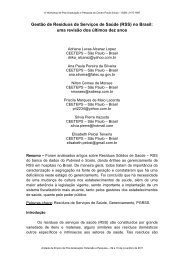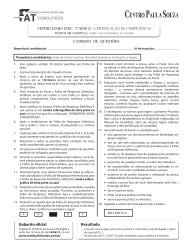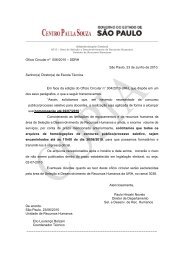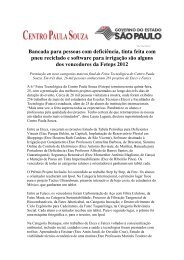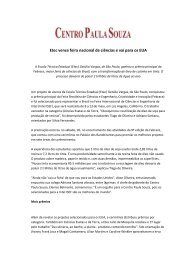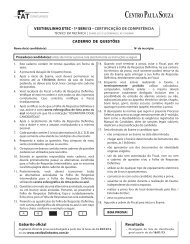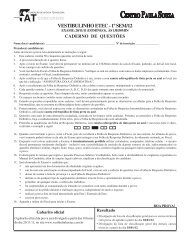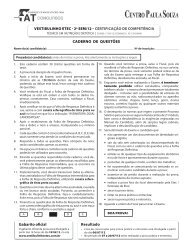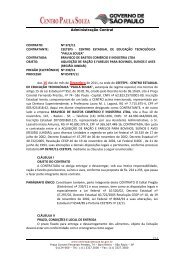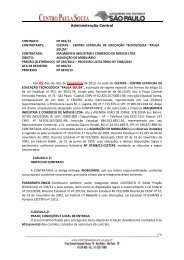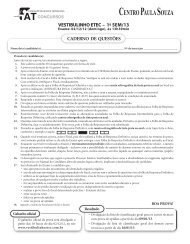Prova-2-1º semestre 2009.indd - Centro Paula Souza
Prova-2-1º semestre 2009.indd - Centro Paula Souza
Prova-2-1º semestre 2009.indd - Centro Paula Souza
You also want an ePaper? Increase the reach of your titles
YUMPU automatically turns print PDFs into web optimized ePapers that Google loves.
Questão 12<br />
Dadas as reações:<br />
H 2 SO 4<br />
i - 2 H 3 C-CH 2 OH H 3 C-CH 2 -O-CH 2 -CH 3 + H 2 O<br />
140ºC<br />
ii - H 3 C-CH 2 OH<br />
H 2 SO 4<br />
170ºC<br />
São feitas as seguintes afirmações.<br />
I. A reação I é uma desidratação intermolecular.<br />
II. O nome oficial do produto orgânico formado na reação I é o éster etoxi etano .<br />
III. A reação II é uma desidratação intramolecular.<br />
IV. O principal produto formado na reação II é o alceno de menor massa molar.<br />
Está correto o que se afirma em<br />
(A) I e II, apenas.<br />
(B) II e III, apenas.<br />
(C) I, III e IV, apenas.<br />
(D) II, III e IV, apenas.<br />
(E) I, II, III e IV.<br />
inglês<br />
Leia o texto abaixo para responder às questões 13, 14, 15 e 16.<br />
The Green Fairy Returns<br />
H 2 C = CH 2 + H 2 O<br />
In the 20,000 years or so that humans have been getting pissdrunk, no spirit has earned a worse rap than absinthe.<br />
Said to turn mild- mannered imbibers into raving maniacs, it was banned in the US and much of Europe in the early<br />
1900s. (Remember Van Gogh’s ear incident? Some scholars blame the green fairy.) The chemical culprit was thujone,<br />
a toxic compound found in the crushed ftowers and leaves of absinthe’s key ingredient, wormwood. Or so we<br />
thought.<br />
Three years ago, WIRED sent me to meet Ted Breaux, a chemist and microbiologist who had reverse engineered<br />
the liquor’s recipe and discovered that there was barely any thujone present (November 2005). During harvest and<br />
distillation, he explained, its concentration was reduced to a minuscule five parts per million.<br />
Breaux’s research-finaIIy published this spring in the Journal of Agricultural and Food Chemistry - and that WIRED<br />
story have helped change absinthe’s image from drug to drink. The US has been slowly peeling away its ban, and<br />
in March, the Alcohol and Tobacco Tax and Trade Bureau approved the sale of absinthes that were “thujone free”<br />
(containing less than 10 parts per million).<br />
To date, there are four brands on US shelves: Lucid (Breaux’s formula), Kübler, Green Moon, and, St. George Absinthe<br />
Verte. “The US is lucky in that its first absinthes are high-quality products, distilled from whole herbs,” Breaux<br />
says. “In the European market, 80 to 90 percent is industrial junk.”<br />
Under the Jade label, Breaux is making his own absinthes in France and trying to get them green-lighted for saIe in<br />
the US. “Even at this point, gaining that approval seems to involve more luck than anything,” he says. Luck, and a<br />
littIe chemistry.<br />
(BRIAN ASHCRAFT - Wired / Aug08)<br />
VEstiBulAr 2º sEm/09 • FAtEC • 7



